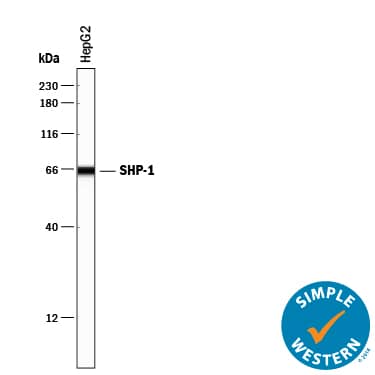Human/Mouse/Rat SHP-1 Antibody
R&D Systems, part of Bio-Techne | Catalog # AF1878

Key Product Details
Species Reactivity
Validated:
Human, Mouse, Rat
Cited:
Mouse
Applications
Validated:
Simple Western, Western Blot
Cited:
Western Blot
Label
Unconjugated
Antibody Source
Polyclonal Goat IgG
Product Specifications
Immunogen
E. coli-derived recombinant human SHP-1
Ala205-Lys595
Accession # P29350
Ala205-Lys595
Accession # P29350
Specificity
Detects human, mouse, and rat SHP-1. The antibody does not detect SHP-2 in Western blots.
Clonality
Polyclonal
Host
Goat
Isotype
IgG
Scientific Data Images for Human/Mouse/Rat SHP-1 Antibody
Detection of Human/Mouse/Rat SHP‑1 by Western Blot.
Western blot shows lysates of HepG2 human hepatocellular carcinoma cell line and Nb2-11 rat lymphoma cell line. PVDF membrane was probed with 0.5 µg/mL Goat Anti-Human/Mouse/Rat SHP-1 Antigen Affinity-purified Polyclonal Antibody (Catalog # AF1878) followed by HRP-conjugated Anti-Goat IgG Secondary Antibody (Catalog # HAF109). For additional reference, Recombinant Human Active SHP-1 aa 205-595 (Catalog # 1878-SH) and Recombinant Human SHP-2 (Catalog # 1894-SH) (2 ng/lane) were included. A specific band for SHP-1 was detected at approximately 70 kDa (as indicated). This experiment was conducted under reducing conditions and using Immunoblot Buffer Group 1.Detection of Human SHP‑1 by Simple WesternTM.
Simple Western lane view shows lysates of HepG2 human hepatocellular carcinoma cell line, loaded at 0.2 mg/mL. A specific band was detected for SHP-1 at approximately 65 kDa (as indicated) using 5 µg/mL of Goat Anti-Human/Mouse/Rat SHP-1 Antigen Affinity-purified Polyclonal Antibody (Catalog # AF1878) followed by 1:50 dilution of HRP-conjugated Anti-Goat IgG Secondary Antibody (Catalog # HAF109). This experiment was conducted under reducing conditions and using the 12-230 kDa separation system.Applications for Human/Mouse/Rat SHP-1 Antibody
Application
Recommended Usage
Simple Western
5 µg/mL
Sample: HepG2 human hepatocellular carcinoma cell line
Sample: HepG2 human hepatocellular carcinoma cell line
Western Blot
0.5 µg/mL
Sample: HepG2 human hepatocellular carcinoma cell line and Nb2-11 rat lymphoma cell line
Sample: HepG2 human hepatocellular carcinoma cell line and Nb2-11 rat lymphoma cell line
Formulation, Preparation, and Storage
Purification
Antigen Affinity-purified
Reconstitution
Reconstitute at 0.2 mg/mL in sterile PBS. For liquid material, refer to CoA for concentration.
Formulation
Lyophilized from a 0.2 μm filtered solution in PBS with Trehalose. *Small pack size (SP) is supplied either lyophilized or as a 0.2 µm filtered solution in PBS.
Shipping
Lyophilized product is shipped at ambient temperature. Liquid small pack size (-SP) is shipped with polar packs. Upon receipt, store immediately at the temperature recommended below.
Stability & Storage
Use a manual defrost freezer and avoid repeated freeze-thaw cycles.
- 12 months from date of receipt, -20 to -70 °C as supplied.
- 1 month, 2 to 8 °C under sterile conditions after reconstitution.
- 6 months, -20 to -70 °C under sterile conditions after reconstitution.
Background: SHP-1
References
- Tsui, H.W. et al. (1993) Nature Genet. 4:124.
- Matthews, R.J. et al. (1992) Mol. Cell. Biol. 12:2396.
- Burshtyn, D.N. et al. (1997) J. Biol. Chem. 272:13066.
- Pei, D. et al. (1994) Biochemistry 33:15483.
- Tomic, S. et al. (1995) J. Biol. Chem. 270:21277.
Long Name
Src Homology Region 2 Domain Phosphatase 1
Alternate Names
HCPH, PTP1C, PTPN6, SHP1
Gene Symbol
PTPN6
UniProt
Additional SHP-1 Products
Product Documents for Human/Mouse/Rat SHP-1 Antibody
Product Specific Notices for Human/Mouse/Rat SHP-1 Antibody
For research use only
